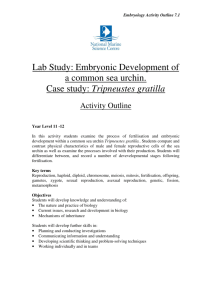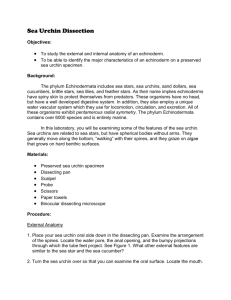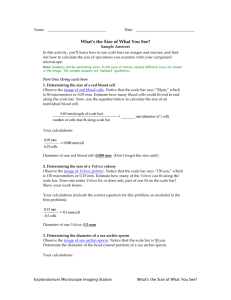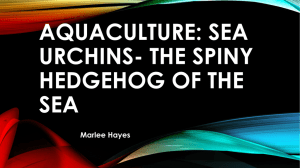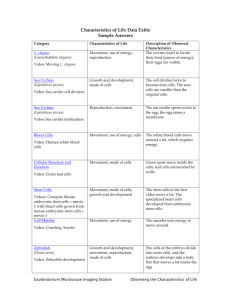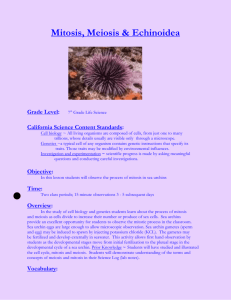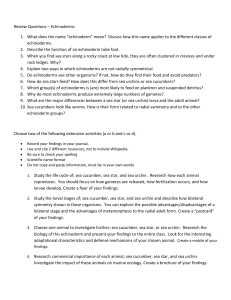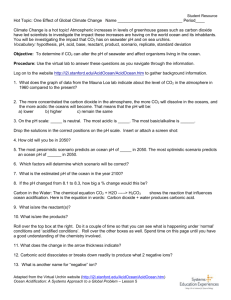A Century of Sea Urchin Development Susan G
advertisement
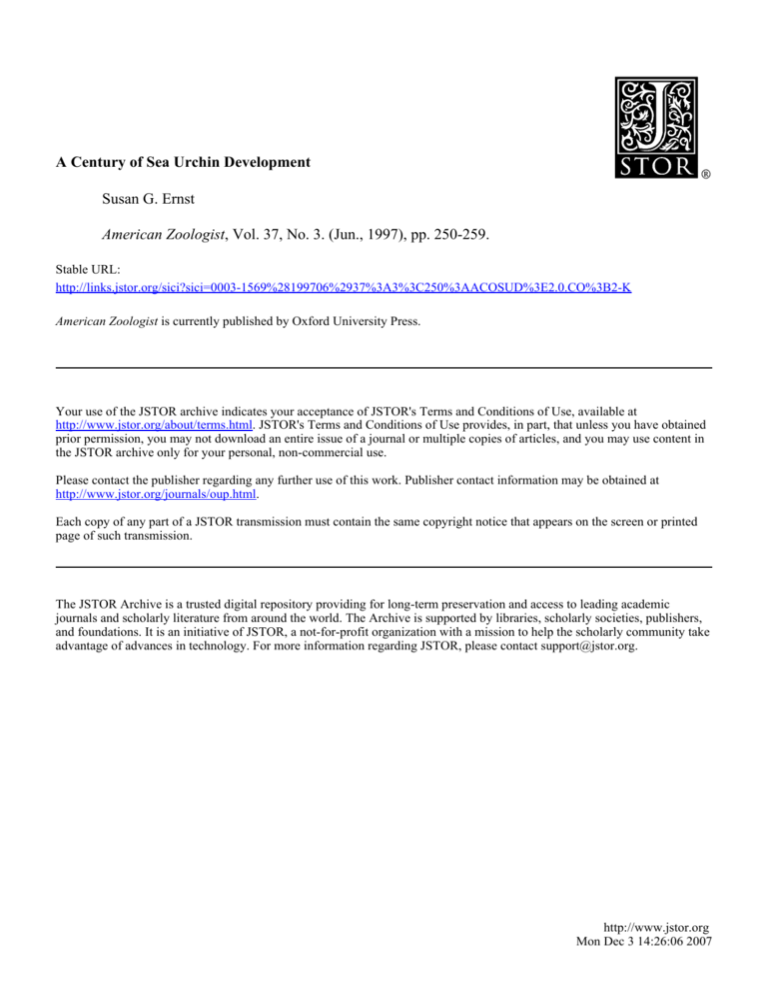
A Century of Sea Urchin Development Susan G. Ernst American Zoologist, Vol. 37, No. 3. (Jun., 1997), pp. 250-259. Stable URL: http://links.jstor.org/sici?sici=0003-1569%28199706%2937%3A3%3C250%3AACOSUD%3E2.0.CO%3B2-K American Zoologist is currently published by Oxford University Press. Your use of the JSTOR archive indicates your acceptance of JSTOR's Terms and Conditions of Use, available at http://www.jstor.org/about/terms.html. JSTOR's Terms and Conditions of Use provides, in part, that unless you have obtained prior permission, you may not download an entire issue of a journal or multiple copies of articles, and you may use content in the JSTOR archive only for your personal, non-commercial use. Please contact the publisher regarding any further use of this work. Publisher contact information may be obtained at http://www.jstor.org/journals/oup.html. Each copy of any part of a JSTOR transmission must contain the same copyright notice that appears on the screen or printed page of such transmission. The JSTOR Archive is a trusted digital repository providing for long-term preservation and access to leading academic journals and scholarly literature from around the world. The Archive is supported by libraries, scholarly societies, publishers, and foundations. It is an initiative of JSTOR, a not-for-profit organization with a mission to help the scholarly community take advantage of advances in technology. For more information regarding JSTOR, please contact support@jstor.org. http://www.jstor.org Mon Dec 3 14:26:06 2007 A Century of Sea Urchin Development1 SUSANG. ERNST Department of Biology, Tufts University, Medford, Massachusetts 02155 SYNOPSIS.In the last quarter of the nineteenth century several investigators including Richard and Oskar Hertwig, Theodor Boveri, Hans Driesch, Curt Herbst, T. H. Morgan and others turned their attention to sea urchin eggs and early embryos. This favorable combination of outstanding investigators and the sea urchin embryo as an experimental organism contributed to a fundamental understanding of the cell, fertilization and heredity. The advantages of the sea urchin continued to be recognized as experimental embryologists used these embryos to develop the concepts of gradients, regulative development and inductive interactions. Then, as developmental biology arose from chemical embryology, the sea urchin embryo once again emerged as an ideal experimental animal, pivotal in the understanding of the molecular and developmental biology of eukaryotic organisms. "It was the uncontested merit of Oskar Hertwig to have, with a single brilliant stroke, illuminated the field. Up until that time [1875], relatively unsuitable material had been used for study . . . Oskar Hertwig selected for his first investigation the sea urchin and found thereby an object in which so many favorable circumstances coincide, that even today, at least for the observation in the living state, it is unsurpassed." Thus wrote Theodor Boveri in his second cell study in 1892 (Boveri, 1892 cited in Baltzer, 1962, Rudnick translation, 1967, p. 69) and today many developmental biologists are still finding the sea urchin embryo unsurpassed for observations in the living state. Eggs and embryos are relatively transparent making it easy to observe fertilization and developmental events. The adults are easily maintained in a laboratory and millions of mature gametes can be obtained from a single individual. Fertilization is external and embryogenesis in sea water is rapid, synchronous and relatively simple. Just a glance at the numerous outstanding books (Giudice, 1973; 1986; Stearns, 1974; Czihak, 1975) on sea urchin embryos makes it immediately obvious that any short review on the history of sea urchin From the Symposium Forces in Developmental Biology Research: Then and NOW presented at the Annual Meeting of the Society for Comparative and Integrative Biology, 26-30 December 1995, at Washington, D.C. development will be limited in scope and idiosyncratic. Of the many topics that have been excluded due to space constraints, two require at least mention. First, investigations on sperm-egg interactions and egg activation in the sea urchin have contributed more to our understanding of fertilization than studies from any other organism. Much of the early work on fertilization using sea urchins can be found in Runnstrom (1951). A second area not covered here, but where sea urchin embryogenesis has contributed greatly to asking, as well as answering fundamental questions is morphogenesis. The reader is referred to Ettensohn and Ingersoll (1992) for an excellent recent review on this subject. Here we take a primarily chronological approach to the history of sea urchin development. However, the strong experimental and intellectual continuity of some ideas necessitated the uninterrupted following of their development once the thread was picked up. This review highlights ways in which the sea urchin embryo has helped generations of investigators conceptualize basic biological questions and has supplied answers to problems in the fields of genetics, cell, developmental and molecular biology. In addition, it draws attention to the great extent to which our current progress and models of sea urchin development rely on the meticulous observations and the clear and cre- ative thinking of those who have gone before us. For simplicity I have divided this history into three periods. The divisions are, of course, artificial but serve primarily to organize an enormous amount of information. The first period with an arbitrary start date around 1875 continued until the 1920s. It was during the first period that studies on the sea urchin resulted in the understanding of the process of fertilization and the chromosome theory of heredity. It was also during this period that the unequal potential of the regions of the egg was discovered. Studies in the second period from the 1920s through the 1950s and into the early 1960s are grouped into two major areas: experimental embryology and chemical embryology. During the third period (1950-1975) investigators of sea urchin development made major contributions to the emerging concepts of the central dogma. There are several reports of early microscopic observations of sea urchin eggs and developing embryos (DufossC, 1847 cited in Monroy, 1986; Von Baer, 1847 cited in Needham, 1950, p. 99; Derbks, 1847 cited in Horstadius, 1973, p. 10). However, as pointed out by the opening quotation by Boveri, it was Oskar Hertwig's careful cytological observations made after adding sperm to eggs that drew attention to the sea urchin as an organism of choice for the study of fertilization and embryogenesis. Taking advantage of the remarkable optical clarity of sea urchin eggs, 0 . Hertwig demonstrated that fertilization is the result of the fusion of two pronuclei (Hertwig, 1876). Around the same time that other investigators observed pronucleus fusion in snails and Ascaris (reviewed in Davidson, 1976), Hertwig's discovery focused attention on the importance of the nucleus and thereby provided the explanation of the role of the two parents in fertilization and development. No sooner had the importance of 0. Hertwig's discovery of pronuclear fusion been understood when Oskar Hertwig and his brother Richard started shaking sea urchin eggs. Working at the Marine Station of An- ton Dohrn in Naples, the Hertwigs found that when they shook sea urchin eggs they sometimes produced egg fragments that could repair themselves. More surprisingly, they also discovered that when egg fragments without nuclei were fertilized by sperm, the resulting merogones could complete relatively normal development with only the male pronucleus (Hertwig and Hertwig, 1887). Around the same time Jacques Loeb at Woods Hole was fascinated with the question of why sea urchin eggs die unless they are fertilized. He devised a "lysin-corrective factor" method for parthenogenesis (reviewed in Loeb, 1913). Separate treatment of eggs with butyric acid and with hypertonic sea water resulted in lifting of the fertilization membrane, initiation of normal cleavage, and complete parthenogenetic development (Loeb, 1913). These two lines of experimentation, the development of merogones with only the sperm nucleus and the development of parthenogenetic activated eggs with only the female pronucleus, demonstrated that the chromosomes from the female and the male are developmentally and genetically equivalent. In 1888 Roux reported that killing one blastomere of the 2-cell stage amphibian embryo produced a partial embryo, suggesting that the egg is a mosaic of independent parts partitioned during cleavage (Roux, 1888). By selecting the sea urchin embryo where he could completely separate the first two blastomeres by shaking, Dreisch found a dramatically different result: two perfect, but diminutive sea urchin embryos. This first description of regulative development, along with his classic pressure plate experiments, in which Dreisch found that nuclei distributed to different regions of the cleaving egg were not qualitatively different from each other, led Dreisch to think of the embryo as a "harmonious equipotential system" and then down the path of vitalism. However, from Dreisch's work comes the first understanding that, depending upon the circumstances, cells from one region of the egg can give rise to parts of the larvae that they would have never formed in normal development (reviewed in Davidson, 1976; 1986). Some of the most important investiga- into three groups, the result was that 11% tions to come from this early period were of the time the three groups would contain the studies of Theodor Boveri. Today Bov- balls representing at least one of each of the eri's contributions remain curiously under- 18 chromosomes. When Boveri analyzed recognized; however, from Boveri's con- the results of 1500 dispermic eggs that ditemporaries and current investigators who vided first to the four cell stage, only one know his work, there is universal recogni- (< 0.1%) developed into a normal pluteus. tion of the seminal nature of his thinking In contrast, 58 of 719 or 8% normal plutei (Morgan, 1894; Sutton, 1902; Goldschmidt, arose from dispermic eggs that had first 1916; Wilson, 1925; Spemann, 1938; Baltz- gone through a three-cell stage, a result er, 1962; Davidson, 1989a; Monroy, 1986). close to the predicted 11%. From this study Boveri received his Ph.D. at the University Boveri concluded that "normal developof Munich in 1885 and soon after became ment is dependent on the normal combian assistant to R. Hertwig. In 1888 he took nation of chromosomes and this can only his first trip to Naples where he made many mean that the individual chromosomes must far-reaching discoveries using sea urchins. possess different qualities" (translation in Boveri named the centrosome and provided Wilson, 1925, p. 920). the early descriptions of the role of the cenBoveri's cytological observations of sea trosome in fertilization and cell division. He urchin chromosomes and their importance also discovered the jelly canal and realized in heredity and development complemented its importance in marking the animal pole Mendel's genetic results. Sutton's 1902 pa(reviewed in Baltzer, 1962). per on the chromosomes in the "lubber Space permits the description of only one grasshopper" Brachystola magna opens of Boveri's many ground breaking experi- with the following: "The appearance of ments. At the time Weismann and others Boveri's recent remarkable paper on the held that all chromosomes were essentially analysis of the nucleus by means of obseridentical, while Roux suggested that indi- vations on double-fertilized eggs has vidual chromosomes were different. Boveri prompted me to make a preliminary comdesigned the following experiment to dis- munication of certain results . . . " and clostinguish between these two possibilities es with, "the evidence advanced in the case (Boveri, 1907; reviewed in Wilson, 1925; [of Brachystola] is obviously more in the Baltzer, 1962). If an egg is fertilized with nature of suggestion than of proof, but it is two sperm, the result of the first cleavage offered in this connection as a morphologis a four, rather than a two-cell stage. Fur- ical complement to the beautiful experithermore, T. H. Morgan discovered that if mental researches of Boveri [where] he has you shake dispermic eggs before the first artificially accomplished for the various division the result is often a three-cell stage. chromosomes of the sea urchin the same Boveri reasoned that in dispermic eggs of result . . . " (Sutton, 1902, p. 24 and p. 39). Paracentrotus lividus there would be a Still today, many textbooks on genetics regreater chance of getting a complete set of fer to the Sutton-Boveri chromosome theall 18 chromosomes in the cleavage blas- ory. tomeres of three, rather than four cells. Boveri also noticed that most dispermic Boveri modeled this experiment using num- sea urchin embryos go through normal bered balls to represent the 54 chromo- cleavage and only at the beginning of gassomes and a device to randomly separate trulation do they start to manifest abnormal them into groups to determine the proba- development. This observation, along with bility of finding a complete set of chromo- his own evidence and that of Driesch, 0. somes in each blastomere of a triaster or and R. Hertwig and several others on hytetraster egg. Two hundred throws of the brid species crosses, lead Boveri to conballs suggested that none of the 4-cell em- clude that there are two developmental bryos would have all 18 chromosomes and, phases (reviewed in Baltzer, 1962; Davidtherefore, none would develop normally. son, 1976; Giudice, 1986). Furthermore, When the balls were randomly distributed Boveri was aware that the cytoplasm was in large part responsible for the early developmental phase controlling the timing and pattern of the early cleavages. This classic observation then waited over 50 years for explanation with the discovery of stored maternal mRNA and protein in the 1960s. In 1883 Selenka discovered a band of reddish pigment granules in the Paracentrotus egg (Selenka, 1883 cited in Horstadius, 1975a). During oogenesis these pigment granules are evenly distributed in the egg cortex and upon germinal vesicle breakdown, they redistribute in a band below the equator, forming a ring with pigment excluded from the vegetal pole. The granules are partitioned during cleavage such that during gastrulation the red cells invaginate to produce the archenteron. Morgan discovered that reddish pigment of Arbacia eggs moves away from the vegetal pole at the four-cell stage. His careful microscopic observation led him to conclude that "as early as the two cell stage the protoplasm of the Arbacia egg is not isotropic but even at this time the micromere field is foreshadowed" (Morgan, 1894, p. 142). In 1901 when Boveri first saw the pigment ring in Paracentrotus he wrote to Hans Spemann, his first Ph.D. student and lifelong friend, "I now believe that I can with full confidence assert the inequipotentiality of the sea urchin egg" (in Balzer 1962, Rudnick translation, 1967, p. 55). In a paper he wrote, "A study of the development showed that the egg axis determined by the pigment ring coincided with the axis of cleavage and with that of the gastrula. Since the possibility presented here of relating the polarity of the larva back to a visible polarity of the egg is of great importance for a whole series of developmental questions, I determined to inquire into the relations as far as possible." (Boveri, 1901; Balzer 1962; Rudnick translation, p. 110). He did get very far indeed in recognizing the importance of the vegetal cytoplasm and of the micromeres, concluding "that the area nearest the vegetal pole possess the greatest potential to bring development completely to the pluteus stage. It is the priority region where differentiation beings. And when differentiation has begun from this center all other regions are determined in their role by a regulatory action" (Rudnick translation, p. 111). This idea is clearly the precursor to the concept of the organizing center of Spemann. In describing the origin of the concept of the blastopore being "a center of differentiation as the starting point for determination" in amphibians, Spemann wrote "A similar interpretation had been considered by Boveri (1901) many years earlier for the development of the sea urchin egg [in which] the relatively most vegetative point . . . might be a 'privileged region' from which everything else would be determined. I could myself (Spemann and Hilde Mangold, 1924) point out the likeness of the two conceptions when, many years later, I again came across this interpretation of Boveri. It may have been working subconsciously after I encountered it in the publication just mentioned, or even in oral communication, or it may have been part of our common stock of ideas in those invaluable years of daily intercourse with that great investigator" (Spemann, 1938, p. 142. I was directed to this passage by Oppenheimer, 1967). Two marvelous observations were made in the 1890s by Curt Herbst studying the factors of sea water that were important to normal development. The first observation, that early sea urchin embryos can be dissociated into single cells by placing them in calcium-free sea water (Herbst, 1892), represented a major technical advance over separation by shalung. A multitude of current investigations on isolated populations of sea urchin blastomeres, as well as all the dissociation and reaggregation studies (reviewed in Giudice, 1986), rely on Herbst's observation. In his analysis of the important components of sea water, Herbst also discovered that several ions, most important among them lithium, cause the vegetal plate of sea urchin embryos to push out rather than to invaginate (Herbst, 1892). The resulting exogastrula are characterized by an external, but morphologically normal, digestive system at low lithlum concentration and embryos with additional endoderm and morphological abnormalities when the lithium concentration is increased. Lithium-induced exogastrula were extremely impor- tant in thinlung about the potential of different regions of the egg and introduced the concept of vegetalizing agents. Today a number of investigators, principal among them Fred Wilt and his collaborators, have studied the effect of lithium on sea urchin embryogenesis and propose that an inositolphosphate second messenger pathway, perhaps working through protein b a s e C, must be a key component of cell fate assignment along the animal-vegetal axis (reviewed in Wilt et al., 1995). A rather simple observation made during this early period serves as another beautiful illustration of the value of the sea urchin embryo as an experimental system. In 1887 Laurent Chabry, a French embryologist, cut into a sea urchin egg with a fine glass needle (Horstadius, 1973). This roughly treated Paracentrotus egg healed and developed into a normal pluteus, demonstrating that these eggs and embryos can withstand significant experimental insults and still develop normally. Since Chabry's observation, many investigators have felt as Driesch did when he wrote that "I had 'luck' . . . precisely that the sea urchin egg was able to put up with my intervention without dying." (Baltzer, 1962, Rudnick translation, p. 113). This property of sea urchin embryos made possible the marvelous blastomere isolation and recombination experiments of Horstadius and also current transplantation and removal experiments, as well as, the microinjection of DNA, RNAs, and antibodies into eggs and embryos (reviewed in Emst, 1997). During this period two major and somewhat independent lines of investigation were occurring in sea urchin embryology. This is the time of the great flowering of experimental embryology with Horstadius as the undisputed leader in sea urchins, actively publishing in the field for over 50 years. In this review we can but just mention some of Horstadius' most outstanding and far reaching accomplishments and refer the reader to major reviews of his work (Horstadius, 1973; 19753). Using Nile blue to mark individual blastomeres after the method of Lindahl, Horstadius created the first fate map of early sea urchin development (reviewed in Horstadius, 1973). Horstadius' fate map as envisioned in the 1930s has needed elaboration and refining, but only minor revision, as others have reinvestigated the map by injecting fluorescently labeled dyes into individual blastomeres (Cameron et al., 1987; 1990; 1991). However, it is more for his blastomere isolation and transplantation experiments that Horstadius is best known. He first confirmed the early work of Zoja who in 1895 separated 16-cell sea urchin embryos at the equator to produce animal and vegetal halves and found that a cultured animal half produced only a ciliated ball of epithelium that Zoja called permanent blastula (Zoja, 1895 cited in Horstadius 1 9 7 5 ~ )Horstad. ius found that the subsequent addition of more vegetal tiers of cells to animal hernispheres resulted in differentiation of a greater number of cell types, tissues and structures (reviewed in Horstadius, 1973). However the entire embryo, with a normal gut (endoderm) and skeletal system (mesoderm) did not form without cells from the most vegetal region. The inducing influence of the rnicromeres postulated by Boveri was demonstrated by Horstadius' elegant transplantation experiments. He took micromeres from a donor 16-cell stage embryo and transplanted them to the animal pole region of a host embryo. At the blastula stage the host's primary mesenchyme cells, descendants of the micromeres, entered the blastocoel from the vegetal plate and donor primary mesenchyme cells entered the blastocoel from the animal pole. A full-sized archenteron was produced and a small secondary archenteron (endoderm) was induced to form from animal cap cells which, in the normal embryo or in isolation, produce only ectoderm (Horstadius, 1935; reviewed in Horstadius, 1973). Ransick and Davidson (1993) have recently confirmed Horstadius' result, inducing a second differentiated gut by transplanted micromeres. They have further demonstrated that a signal from the micromeres is required for the specification of the vegetal plate in normal development and that the vegetal plate has received this information by the sixth cleavage (Ransick and Davidson, 1995). Horstadius was also instrumental in refining and articulating succinctly the doublegradient theory of sea urchin development (reviewed in Horstadius, 1975b). Boveri, who in 1910 first introduced the term "geWlle" or gradient into embryology (Horstadius, 1975a), believed that there was a single gradient in sea urchins, emanating from the vegetal pole. In the 1920s Runnstram proposed that the two poles of the sea urchin egg are dynamic centers from which gradients of animalizing and vegetalizing morphogenetic substances diffuse (reviewed in Runnstrom, 1975). He envisioned that these gradients are normally balanced in sea urchin development, but agents such as zinc or lithium could destroy this balance resulting in one gradient winning out and the corresponding "animalization" or "vegetalization" of the embryo. Horstadius, Lindahl, Child and others embraced and elaborated Runnstrom's double-gradient theory (reviewed in Dalcq, 1938; Horstadius, 1975b). However several investigators reevaluating current data have concluded that early sea urchin embryology can best be explained by the vegetal cytoplasm being autonomously specified and the micromeres then sending signals to the overlying macromeres (Wilt, 1987; Hurley et al., 1989; Davidson, 1989b; Livingston and Wilt, 1990; Ettensohn and Ingersoll, 1992; Ransick and Davidson, 1995). Current models to explain Horstadius' regulative capabilities and inductive interactions rely on second messenger cascades initiated by ligand-receptor mediated signalling. Furthermore, suppressive as well as inductive ligand-receptor interactions are proposed to activate cascades of signal transduction mechanisms which would modify DNA binding factors and regulate lineage specific gene expression (e.g., Henry et al., 1989; Khaner and Wilt, 1990; Brandhorst and Klein, 1992). Along with the field of experimental embryology another new discipline was emerging: chemical embryology. Barth (1950) has suggested that chemical embryology began around 1900 with the studies of Jacques Loeb. Loeb's writings from this period reflect that much of his thinlung on the physical and chemical nature of living systems derived from his investigations on the effect of various chemicals on sea urchin fertilization, artificial parthenogenesis, and development (Loeb, 1913; 1916). This position is supported by the critical analysis of the importance of the discovery of artificial parthenogenesis by E. E. Just in his book The Biology of the Cell Sugace (Just, 1939). He points out that the significance of Loeb's work is that the effective agent for parthenogenesis is non-specific and that initiation of development is a chemical process. This was a time when many chemists developed a fascination for the properties of living cells and many experimental embryologists came to believe that, in the words of Jean Brachet, "current ideas about germinal localization, induction, fields, and gradients ought to be founded as much as possible on a basis of precise chemical information" (Brachet, 1945, p. vii). Once again sea urchin eggs and embryos were frequently the experimental material of choice as demonstrated by Otto Warburg's dramatic discovery that fertilization or parthenogenetic activation of Arbacia eggs produced a major burst of oxygen consumption (Warburg, 1908). In the 1930s and 1940s Child measured physiological gradients in the developing sea urchin embryo. As Needham wrote "if [the gradient theory in the sea urchin] had T. Boveri for its father, C. M. Child has been its prophet" (Needham, 1950, p. 496). Child measured the anaerobic reduction of methylene blue, and Janus green and detected a center of reducing activity emanating from the animal pole (e.g., Child, 1928). In the 1930-1950s chemical embryologists also found that sea urchins were well suited to the characterization of the role of nucleic acids and protein synthesis in development. Advances in the detection of nucleic acids both cytologically by staining with basic dyes, frequently coupled with nuclease digestion, and by ultraviolet spectroscopy fostered rapid progress. Furthermore, the post war availability of radioactive material enabled biologists to monitor quantitatively DNA, RNA and protein synthesis. An advantage of sea urchin eggs in thaei, 1961). Within the year, several labs reported that ribosomal preparations from sea urchin eggs (Nemer, 1962; Wilt and Hultin, 1962) and rabbit reticulocytes incorporated phenylalanine into proteins upon the addition of polyU, thus demonstrating that the genetic code is universal. Soon after, the incorporation of radioactively labeled amino acids into proteins in parthenogenetically activated merogones (Brachet e,t al., 1963a; Tyler, 1963; Denny and Tyler, 1964) and into chemically enucleated (actinomycin D treated) eggs (Gross and Cousineau, 1963; Brachet et al., 1963b) resulted in the surprising, but inescapable, conclusion that maternal messenger RNAs are stored in sea urchin eggs. These results also initiated a long standing debate and a series of investigations on translational control to determine if protein synthesis was inhibited in unfertilized eggs due to "masked" messages or because the translational machinery was somehow deficient. The dramatic increase in the rate of protein synthesis following fertilization lead to the discovery that many maternal mRNAs stored in the sea urchin egg are polyadenylated upon fertilization in preparation for polysome loading. These were the first reports of cytoplasmic polyadenylation (Slater et al., 1973; Wilt, 1973). In the 1970s, Britten, Davidson and coworkers used DNA.RNA hybridization to establish that a sea urchin gastrula stage embryo contains approximately 14,000 distinct messenger RNAs (Galau et al., 1974). This first quantitation of the complexity of a eukaryotic mRNA population was quickly followed with reports from the same lab on the number of sequences found at other deSpace permits only the briefest review of velopmental stages. Studies on populations sea urchin development from the 1950s un- of mRNAs revealed surprisingly that til approximately 1975. Here, instead, we mRNA populations in sea urchin eggs and present a few highlights of an impressive, early embryos represented far greater combut partial, list of "firsts" that investigators plexity than those found in later stages of studying the sea urchin embryo contributed development and in adult tissues (Galau et to the newly emerging area of molecular al., 1976; Hough-Evans et al., 1977). These and developmental biology of eukaryotic results lead to the proposal that the cytoorganisms. The first step in breakmg the ge- plasm inherited by the micromeres, Bovenetic code was reported when Matthaei and ri's "priority region," might contain localNirenberg, using a bacterial cell-free trans- ized maternal rnRNAs, that would deterlation system, established that polyU coded mine the fate of these cells. Since cleavage for polyphenylalanine (Nirenberg and Mat- is synchronous in the sea urchin embryo this regard is that they readily take up and incorporate nucleic acid and protein precursors added to the sea water. This is a complicated literature frequently characterized by theory ahead of fact. But it is also a literature still vibrant with excitement as one finds gems of information and important insights ready to fall in place with the unifying concept of the central dogma. For instance as early as 1933 when many people thought that DNA existed in the nuclei of animal cells and RNA in plant cells, Brachet's experiments led him to conclude that "the synthesis of nucleic acids in the sea urchin is not intelligible unless we admit the presence of a pentose-nucleic acid (RNA) in the cytoplasm" (Brachet, 1945, p. 65). In his 1945 book entitled Chemical Embryology, Brachet, relying heavily on his work in sea urchins, summarized what was known about the role of nucleic acids in the following manner " . . . the cytochemical findings point irresistibly to the conclusion that nucleic acids must take part in the synthesis of proteins (his italics) and that DNA in the nucleus regulates the amount of ribonucleoproteins in the cytoplasm, that the ribonucleoproteins in the cytoplasm are bound to granules . . . and these various substances probably collaborate to synthesize proteins: the amino acids might be arranged on the surface of the granules in a precise pattern" (Brachet, 1945; p. 246). So by the time Watson and Crick described the structure of DNA in 1953, the sea urchin embryo had been established firmly as an ideal organism for the study of this new area of molecular biology. and the blastomeres can be dissociated in calcium-free sea water and separated by size, it was now possible to address this long standing question. Rodgers and Gross (1978) and Ernst et al. (1980) found that the micromeres contained a subset of the maternal RNA sequences of the 16-cell stage embryo using RNA-DNA hybridization. These results are the first direct measurement of unequal distribution of maternal mRNA in any early cleavage stage embryo, although indirect evidence had been previously reported in Zlyanassa (Donohoo and Kafatos, 1973; Newrock and Raff, 1975). The protein cyclin was first discovered in sea urchin embryos due, in part, to the exquisite synchrony of the early cleavages (Evans et al., 1983). Interestingly, over twenty years earlier Hultin had predicted the existence of cyclins, also using sea urchins when he found that protein synthesis was necessary for cell division and reported that, "The mitotic block induced by puromycin is probably a direct effect of the impaired protein metabolism. Special kinds of proteins of importance for the initiation of mitosis may not become produced in sufficient amounts under these conditions" (Hultin, 1961, p. 41). The sea urchin also contributed an important first to the newly emerging techniques of recombinant DNA technology, with the sea urchin early histone genes being the first eukaryotic genes cloned (Kedes et al., 1975). Since that time, over a hundred partial or complete sea urchin gene sequences have been characterized (reviewed in Giudice, 1995). Recent reviews (see: Ernst, 1997) serve to emphasize that studies on sea urchin embryogenesis will continue to enrich and illuminate our understanding of the mechanisms and molecules responsible for creating a multicellular organism. Professor R. Weiss of Tufts University is gratefully acknowledged for his generous assistance with German and Italian. This work was partially supported by a Tufts University Mellon Faculty Research Award. Baltzer, E 1962. Theodor Boveri, Leben and werk eines grossen biologen. English translation: Rudnick, D. 1967. University of California Press, Berkeley. Barth, L. G. 1950. Translators Preface: to Jean Brachet, Chemical embryology. 1945. Interscience Publisher's, Inc., New York. Boveri, T. 1892. Befruchtung. Erg. d. Anat. u. Entw.Geschc. 1:386-485. Boveri, T. 1901. Uber die polaritat des seeigeleies. Verh. d. Psy-med. Ges. Wiirzburg, N.E 34:145176. Boveri, T. 1907. Zellenstudien VI: Die entwicklung dispermer seeigeleier. Ein beitrag zur befruchtungslehre und zur theorie des kenes. Jena. Zeitschr. Naturw. 43: 1-292. Brachet, J. 1945. Chemical embryology. In English Translation: Banh, L.C. 1950. Interscience Publishers, Inc., New York. Brachet, J., A. Ficq, and Tencer, R. 1963a. Amino acid incorporation into proteins of nucleate and anucleate fragments of sea urchin eggs: Effect of parthenogenetic activation. Exp. Cell Res. 32: 168-170. Brachet, J., M. Decroly, A. Ficq, and J. Quertier. 1963b. Ribonucleic acid metabolism in unfertilized and fertilized sea urchin eggs. Biochim. Biophys. Acta 72:660-662. Brandhorst, B. P. and W. H. Klein. 1992. Territorial specification and control of gene expression in the sea urchin embryo. Seminars in Dev. Biol. 3: 175186. Cameron, A,, S. Fraser, R. Britten, and E. H. Davidson. 199 1. Macromere cell fates during sea urchin development. Development 113: 1085-1091. Cameron, R. A,, S. E. Fraser, R. J. Britten and E. H. Davidson. 1990. Segregation of oral from aboral ectoderm blastomeres is completed at the fifth cleavage in the embryogenesis of Strongylocentrotus purpuratus. Dev. Biol. 137:77-85. Cameron, R. A,, B. Hough-Evans, R. Britten, and E. H. Davidson. 1987. Lineage and fate of each blastomere of the eight-cell sea urchin embryo. Genes Dev. 1:75-84. Child, C. M. 1928. The physiological gradients. Protoplasma 5:447-476. Czihak, G. (ed.). 1975. The sea urchin embryo: Biochemistry and morphogenesis. Springer-Verlag. Berlin. Dalcq. 1938. Form and causaliy in early development. Cambridge at the University Press. Davidson, E. H. 1976; 1986. Gene activiy and early development. 2nd ed.; 3rd ed. Academic Press, New York. Davidson, E. H. 1 9 8 9 ~ .Genome function in sea urchin embryos: Fundamental insights of Th. Boveri reflected in recent molecular discoveries. In T. H. Horder, J. A. Witkowski, and C. C. Wylie (eds.), 8th Symposium of the British Soc. of Developmental Biology, pp. 397-406. Cambridge University Press. Davidson, E. H. 19896. Lineage-specific gene expression and the regulative capacities of the sea urchin mensetzung des umgebenden mediums auf die enembryo: A proposed mechanism. Developnlent 105:421-445. twicklung der tiere I teil. Versuche an seeigeleiern. Z. Wiss. Zool. 55:44&518. Denny, l? C. and A. Tyler. 1964. Activation of protein biosynthesis in non-nucleate fragments of sea ur- Hertwig, 0 . 1876. Beitragezurkenntniss der bildung, befruchtung und theilung des thierischen eies. chin eggs. Biochem. Biophy. Res. Comm. 14: Morph. Jb. 1:347-432. 245-249. Hertwig, 0 . and R. Hertwig. 1887. ~ b e den r befruchDonohoo, l? and F. C. Kafatos. 1973. Differences in tungs-und teilungs-vorgang des tierischen eies unthe proteins synthesized by the progeny of Ilyter dem einfluss asserer agentien. Jena. Z. Naturanassa, a "mosaic" embryo. Dev. Biol. 32:224wiss. 20: 120. 229. Driesch, H. 189 1. Entwicklungsmechanische studien, Horstadius, S. 1935. Uber die determination in verI. Der werth der beiden ersten furchungszellen in laute der eiachse bei seeigeln. Pubbl. Sta. Zool. der echinodermentwicklung. Experimentelle erNapoli 14:251-479. zeugen von theil-und doppelbildung. Zeitschr. Horstadius, S. 1973. E,~peritnental etnbryology of Wissenschaft. Zool. 53:16&178. Abridged Enechinoderms. Clarendon Press, Oxford. Horstadius, S. 1975a. 1. Introducing History. In Cziglish translation: B. Willier and J. M. Oppenheirner (eds.). 1974. Foundations of experimental hak (ed.), The sea urchin embryo. Biachemistrl). and morphogenesi.s, pp. 1-9. Springer-Verlag, embryology. Hafner Press, New York. Ernst, S. G. 1996. Recent advances in early develNew York. Horstadius, S. 19756. 13. Isolation and Transplantaopment of the sea urchin embryo. In K. G. Adition Experiments. In Czihak (ed.), The sea urchin yodi and R. G. Adiyodi (eds.), J. R. Collier (guest ed.) Reproductive biology of the invertebrates. embno. Biochernistn and rnorphogenesis, pp. Progress in developmental biology, (In press.) 364-406. Springer-Verlag. New York. Emst, S. G., B. Hough-Evans, R. J. Britten, and E. H. Hough-Evans, B. R., B. J. Wold, S. G. Ernst, R. J. Davidson. 1980. Limited complexity of the RNA Britten, and E. H. Davidson. 1977. Appearance in micromeres of sixteen-cell sea urchin embryos. and persistence of maternal RNA sequences in sea Dev. Biol. 79:119-127. urchin development. Dev. Biol. 60:258-277. Ettensohn, C. A. and E. l? Ingersoll. 1992. MorphoHultin, T. 1961. The effect of puromycin on protein genesis of the sea urchin embryo. In E. E Rosmetabolism and cell division in fertilized sea ursomando and S. A. Alexander (eds). Analysis of chin eggs. Experientia 17:410-411. the development of biological form, pp. 189-262. Hurley, D. L., L. M. Angerer, and R. C. Angerer. 1989. Marcel Dekker, Inc., New York. Altered expression of spatially regulated genes in Evans, T., E. T. Rosenthal, J. Youngblom, D. Distel, progeny of separated sea urchin blastomeres. Deand T. Hunt. 1983. Cyclin: A protein specified by velopment 106:567-579. maternal mRNA in sea urchin eggs that is de- Just, E. E. 1939. The biology c$ the cell surfnce. l? stroyed at each cleavage division. Cell 33:389Blakistan's Son and Co., Inc. Philadelphia. 396. Kedes, L., A. Chang, D. Houseman, and S. Cohen. Galau, G. A,, Britten, R. J., and E. H. Davidson. 1974. 1975. Isolation of histone genes from unfracA measurement of the sequence complexity of potioned sea urchin DNA by subculture cloning in lysomal messenger RNA in sea urchin embryos. E. coli. Nature 225:533-538. Cell 2:9-20. Khaner, 0 . and E Wilt. 1990. The influence of cell Galau, G. A,, W. Klein, M. M. Davis, B. J. Wold, R. interactions and tissue mass on differentiation of J. Britten, and E. H. Davidson. 1976. Structural sea urchin mesomeres. Development 1091626gene sets active in embryos and adult tissues of 634. the sea urchin. Cell 7:487-505. Livingston, B. T. and E H. Wilt. 1990. Determination Giudice, G. 1973. Developmental biology of the sea of cell fate in sea urchin embryos. Bioessays 12: urchin embryo. Academic Press. New York. 115-119. Giudice, G. 1986. The sea urchin embryo. Springer- Loeb, J. 1913. Arttficial parthenogenesis and fertilVerlag. Berlin. ization. University of Chicago Press. Guidice, G. 1995. Genes of the sea urchin embryo: Loeb, J. 1916. The organism as a whole frotn a phyAn annotated list as of December 1994. Develop. siochemical vievvpoinr. C. P. Putnam's Sons, New Growth Differ. 37221-242. York. Goldschmidt, R. 1916. Theodor Boveri. Science 43: Monroy, A. 1986. A centennial debt of developmental 263-270. biology to the sea urchin. Biol. Bull. 171:509Gross, l? R. and G. H. Cousineau. 1963. Effects of 519. actinomycin D on macromolecular synthesis and Morgan, T. H. 1894. Experimental studies on echiearly development in sea urchin eggs. Biochem. noderm eggs. Anat. Anz. 9: 141-152. Biophy. Res. Comnl. 10:321-326. Needham, J. 1950. Biochemistry and morphogenesi.r. Henry, J. R., S. Amemiya, G. A. Wray, and R. A. Raff. Cambridge at the University Press, Cambridge. 1989. Early inductive interactions are involved in Nemer, M. 1962. Interrelation of messenger polyrirestricting cell fates of mesomeres in sea urchin bonucleotides and ribosomes in the sea urchin egg embryos. Dev. Biol. 136:140-153. during embryonic development. Biochem. BioHerbst, C. 1892. Experimentelle untersuchgen iiber phy. Res. Comm. 8:541-515. den einfluss der veranderten chemischen zusam- Newrock. K. M. and R. A. Raff. 1975. Polar lobe specific regulation of translation in embryos of Ilvunassa obsoleta. Dev. Biol. 42:242-261. ~ i r e n b e r g M. , W. and J. H. Matthaei. 1961. The dependence of cell-free protein synthesis in E. coli upon naturally occumng or synthetic polynucleotides. Proc. Natl. Acad. Sci. U.S.A. 47:15881602. Oppenheimer, J. 1967. Essay in the history of embryology and biology. MIT Press. Cambridge, MA. Ransick, A. and E. H. Davidson. 1993. A complete second gut induced by transplanted micromeres in the sea urchin embryo. Science 259:1134-1138. Ransick, A. and E. H. Davidson. 1995. Micromeres are required for normal vegetal plate specification in sea urchin embryos. Development 121:32153222. Rodgers, W. H. and I? R. Gross. 1978. Inhomogeneous distribution of egg RNA sequences in the early embryo. Cell 14:279-288. Roux, W. 1888. Beitrage zur entwickelungsmechanik des embryo. ijber die kunstliche hervorbringung halber embryonen durch zerstorung einer der beiden ersten furchungskugeln, sowie uber die machentwickelung der fehlenden korperhalfte. Vichows Arch. Pathol. Anat. Physiol. Klin. Med. 114:113153. In translation: Willier, B. and Oppenheimer. J . M. (eds.), Foundatiorls oj'E.~peritnentalE m b y ology. Hafner Press, New York. Runnstrom, J. 1951. The problems of fertilization as elucidated by work on sea urchins. The Harvey Lectures, 116-152. Runnstrom, J. 1975. 21. Integrating Factors. In G. Czihak (ed.) The sea urchin embvo: Biochemisrp and morphogenesis. pp. 646-670. Springer-Verlag. New York. Slater, I., D. Gillespie, and D. W. Slater. 1973. Cytoplasmic adenylation and processing of maternal RNA. Proc. Natl. Acad. Sci. U.S.A. 70:406-411. Spemann, H. 1938. Embryonic development and induction. Yale University Pres, New Haven. Steams, L. W. 1974. Sea urchin development: Cellular and molecular aspects. Dowden, Hutchingson and Ross, Inc. Stroudsburg, PA. Sutton, W. S. 1902. On the morphology of the chromosome group in Brachystola magna. Biol. Bull. IV:24-39. Tyler, A. 1963. The manipulations of macromolecular substances during fertilization and early development of animal eggs. Amer. Zool. 3:109-126. Warburg, 0 . 1908. Beobachtungen ueber die oxydationsprozesse im seeigelei. Hoppe-Seyler's Z. Physiol. Chem. 57: 1-16. Wilson, E. B. 1925. The cell in development and heredity, 3rd ed. MacMillan Company, New York. Wilt, E H. 1973. Polyadenylation of maternal RNA of sea urchin eggs after fertilization. Proc. Natl. Acad. Sci. U.S.A. 70:2345-2349. Wilt, E H. 1987. Determination and morphogenesis in the sea urchin embryo. Development 100:559575. Wilt, E and T. Hultin. 1962. Stimulation of phenylalamine incorporation by polyuridylic acid in homogenates of sea urchin eggs. Biochem. Biophys. Res. Comm. 9:313-317. Wilt, E H., B. Livingston, and 0 . Khaner. 1995. Cell interactions in early sea urchin development Amer. Zool. 33:353-357. http://www.jstor.org LINKED CITATIONS - Page 1 of 2 - You have printed the following article: A Century of Sea Urchin Development Susan G. Ernst American Zoologist, Vol. 37, No. 3. (Jun., 1997), pp. 250-259. Stable URL: http://links.jstor.org/sici?sici=0003-1569%28199706%2937%3A3%3C250%3AACOSUD%3E2.0.CO%3B2-K This article references the following linked citations. If you are trying to access articles from an off-campus location, you may be required to first logon via your library web site to access JSTOR. Please visit your library's website or contact a librarian to learn about options for remote access to JSTOR. References Theodor Boveri Richard Goldschmidt Science, New Series, Vol. 43, No. 1104. (Feb. 25, 1916), pp. 263-270. Stable URL: http://links.jstor.org/sici?sici=0036-8075%2819160225%293%3A43%3A1104%3C263%3ATB%3E2.0.CO%3B2-T A Centennial Debt of Developmental Biology to the Sea Urchin Alberto Monroy Biological Bulletin, Vol. 171, No. 3. (Dec., 1986), pp. 509-519. Stable URL: http://links.jstor.org/sici?sici=0006-3185%28198612%29171%3A3%3C509%3AACDODB%3E2.0.CO%3B2-S The Dependence of Cell- Free Protein Synthesis in E. coli upon Naturally Occurring or Synthetic Polyribonucleotides Marshall W. Nirenberg; J. Heinrich Matthaei Proceedings of the National Academy of Sciences of the United States of America, Vol. 47, No. 10. (Oct. 15, 1961), pp. 1588-1602. Stable URL: http://links.jstor.org/sici?sici=0027-8424%2819611015%2947%3A10%3C1588%3ATDOCFP%3E2.0.CO%3B2-4 http://www.jstor.org LINKED CITATIONS - Page 2 of 2 - A Complete Second Gut Induced by Transplanted Micromeres in the Sea Urchin Embryo Andrew Ransick; Eric H. Davidson Science, New Series, Vol. 259, No. 5098. (Feb. 19, 1993), pp. 1134-1138. Stable URL: http://links.jstor.org/sici?sici=0036-8075%2819930219%293%3A259%3A5098%3C1134%3AACSGIB%3E2.0.CO%3B2-7 Cytoplasmic Adenylylation and Processing of Maternal RNA Isabel Slater; David Gillespie; D. W. Slater Proceedings of the National Academy of Sciences of the United States of America, Vol. 70, No. 2. (Feb., 1973), pp. 406-411. Stable URL: http://links.jstor.org/sici?sici=0027-8424%28197302%2970%3A2%3C406%3ACAAPOM%3E2.0.CO%3B2-1 On the Morphology of the Chromosome Group in Brachystola Magna Walter S. Sutton Biological Bulletin, Vol. 4, No. 1. (Dec., 1902), pp. 24-39. Stable URL: http://links.jstor.org/sici?sici=0006-3185%28190212%294%3A1%3C24%3AOTMOTC%3E2.0.CO%3B2-2 Polyadenylation of Maternal RNA of Sea Urchin Eggs after Fertilization Fred H. Wilt Proceedings of the National Academy of Sciences of the United States of America, Vol. 70, No. 8. (Aug., 1973), pp. 2345-2349. Stable URL: http://links.jstor.org/sici?sici=0027-8424%28197308%2970%3A8%3C2345%3APOMROS%3E2.0.CO%3B2-F
